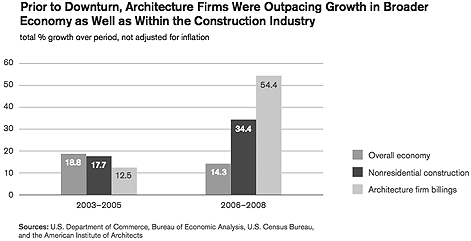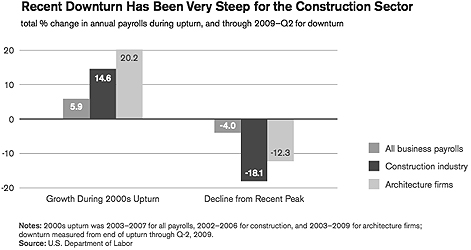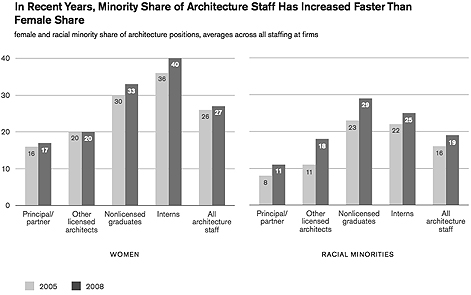Overview
of the 2009 AIA Firm Survey
Comprehensive data on firm business trends just released
Summary: The
AIA published The Business of Architecture:
An AIA Survey Report on Firm Characteristics on October 5. Based on an analysis of 2,699
AIA-member firm responses collected between January and March 2009,
the report is available on-line from the AIA Bookstore. To provide
a comprehensive sense of the information covered in the survey, we
offer here a reprint of the survey overview.
With U.S. architecture firms and the related construction industry
in the midst of its worst downturn of several generations, it’s
easy to forget the solid performance of the profession over the 2005
to 2008 period. This three-year period coincided with the end of
one of the strongest housing booms in our history, as well as a time
when businesses were investing in new facilities to support the healthy
growth in the broader economy.
Even when the housing downturn hit in early 2006, there was sufficient
momentum in the commercial, industrial, and institutional markets
to support solid growth across the profession. By 2008, however,
as the economy was entering a recession, design work at architecture
firms began to slow and then dropped precipitously once credit markets
collapsed toward the end of summer.
For the past two decades, the AIA has conducted periodic surveys
of its member firms. The purpose of these surveys is to document
emerging trends in the practice of architecture and assess how they
interact with economic trends and technological developments. These
Business of Architecture reports present benchmarks that allow firms
to assess their practices and evaluate their operations in comparison
to their peers. In this way, the architecture profession can monitor
its progress toward achieving financial stability while pursuing
shared goals for the larger architecture community. This document
reports results from a scientifically selected survey of 2,700 architecture
firms conducted in early 2009, reporting firm characteristics and
operations in 2008 and comparing these results to earlier surveys
to assess how the profession is changing. Unless otherwise specified,
all information in this report was generated by the AIA.
Economic climate is changing
As economic expansions go, this past
one generated overall favorable business conditions for architecture
firms. Beginning in early 2002, as it emerged from the last recession,
the U.S. economy saw steady growth until the next recession began
in early 2008. The 2003–2005
period saw growth average just about 6 percent per year before inflation
adjustments, while the 2006–2008 period saw economic growth
slow to just under 5 percent per year as the economy headed into
recession in 2008.
Nonresidential construction saw a very different pattern over this
period. Early in economic cycles, as businesses are in recovery mode,
they tend to spend less on investments such as new or modernized
facilities. So, for example, during the past cycle, even though an
economic recovery was under way by 2002, business investment in structures
didn’t begin to rebound until well into 2004, according to
U.S. Commerce Department figures.
However, once under way, spending accelerated very rapidly during
the second half of this cycle, with the Commerce Department reporting
double-digit annual gains on average in non-residential investment
in structures over the 2006–2008 period. The U.S. Census Bureau
reported that nonresidential construction spending increased by more
than 60 34 percent from the end of 2005 to the 50 end of 2008, just
about twice the total growth of the prior three-year period.
Architecture firms benefited greatly from this acceleration of nonresidential
activity. Billings at firms rose sharply between 2005 and 2008: gross
billings were up more than 50 percent due to the spike in pass-throughs,
while net billings increased more than 40 percent from 2005 levels.
The surprisingly strong growth in billings at firms over this period
underscores the “boom or bust” nature of construction
activity and the resulting volatility in revenue at design firms
serving this industry. So, for example, even though the economy grew
at a fairly stable rate over the 2002 to 2008 period, growth in architecture
firm revenue was very modest during the first half of the period
and extremely strong during the second half.

This typical volatility in business conditions at architecture firms
that produced strong growth during the past upturn also generally
produces steep declines during downturns. At the time of this report,
the full extent of the downturn from the recession is unknown, but
it is clear that it will be substantial. Payroll figures, which are
available from the U.S. Department of Labor for a wide range of industries,
already point to a major downsizing of staff at many businesses.
For example, from their peak in 2007 through midyear 2009, U.S. business
payrolls have declined by 5.5 million positions; this decline translates
into 4 percent of all payroll positions nationally, which almost
offsets the total number of payroll jobs added during the upturn
earlier in the decade.
The construction industry has seen a more dramatic downturn. From
its high-water mark in 2006, when the residential sector began to
weaken, through mid-2009, payrolls at construction firms declined
by over 18 percent, more than offsetting all of the job gains during
the upturn earlier in the decade. Payrolls at architecture firms
have followed a similar path. The downturn began later, however,
as the annual peak was in 2008. Still, through the middle of 2009,
payrolls at architecture firms declined by over 12 percent, offsetting
a majority of the gains realized during the upturn.

With a changing construction sector, firms see shifting workloads
Not only did workloads at architecture firms grow dramatically over
the 2006–2008 period, but the composition of those workloads
also shifted. Since the mid-1990s, work on residential facilities
has averaged about 10 to 12 percent of total billings at architecture
firms. However, with the strong growth in homebuilding earlier this
decade, by 2005 residential projects accounted for 18 percent of
billings. By 2008, this share had fallen back closer to its longer
term average.
The increased share of residential work in 2005 offset a downward
trend in commercial construction. That year was still early in the
nonresidential recovery, so commercial design activity was still
below its longer term trend. By 2008, however, commercial activity
had recovered closer to its normal share. Institutional activity,
in contrast, has gradually been increasing its share of design activity
at architecture firms. There was a brief step back in this trend
in 2005, but by 2008 the institutional share was at its highest level
in at least the past 15 years.
The share of activity by construction sector is likely to continue
to shift depending on the position of the construction cycle. As
the economy begins to head in to the next recovery, the residential
market should be the first to rebound, and therefore residential
billings can be expected to increase in share. The nonresidential
downturn is likely to last longer and expected to be the most severe
for commercial facilities, so the commercial share probably will
decline in the near-term.

In spite of some high-profile mergers over the past several years,
architecture firms remain highly fragmented. Almost 80 percent of
AIA member-owned architecture firms had fewer than 10 employees as
of the end of 2008, with just 2 percent of firms reporting 100 or
more employees. With the extensive downsizing at many firms in the
latter part of 2008 and into 2009, it’s likely that many downsized
architects set up smaller practices, further reducing the firm-size
concentration.
Even with the high share of smaller firms, larger firms continue
to account for a large share of activity. By the end of 2008, firms
with 50 or more employees accounted for 44 percent of all staff employed
at architecture firms nationally and over half of all revenue generated
by architecture firms. The small share of firms with 100 or more
employees accounted for 30 percent of all employment and over a third
of all billings. As the construction markets recover and expand,
it is likely that the architecture profession will see a new round
of consolidation. Before the current downturn, many firms were diversifying
into foreign markets to take advantage of international growth opportunities.
Others were diversifying into other regions of the country and across
a broader mix of facility types. This diversification is generally
associated with organic internal growth or merger and acquisition
activity, so as diversification continues, in all likelihood so will
greater consolidation of firms.

Composition of firms changing to accommodate transformation As the
types of construction projects and services offered by architecture
firms have evolved, so has the composition of these firms. One sign
of this is the makeup of the staff at firms. Over the past several
years, the share of architecture staff at firms has generally trended
downward, standing at 60 percent at the end of 2008.
Even more significant than the portion of the staff that provides
architectural services is the composition of this staff. The share
of licensed architects on staff has been trending down, while the
share of nonlicensed graduates of architecture programs not currently
on a licensure path has been steadily increasing. As of this survey,
interns and students as a share of architecture staff declined substantially,
which may be just a temporary trend as firms were scaling back on
less experienced staff when workloads began to slow in 2008.
However, there are likely to be long-term implications of what may
appear to be short-term downsizing. When laid off, interns and other
younger staff have a more difficult time finding work in the architecture
profession. Few other architecture firms are hiring, and it is very
difficult for younger professionals to set up their own practice
in this economic environment. Some will be able to wait out the downturn
and rejoin the profession after the industry recovers. Others will
seek employment in alternative professions, and for these young professionals,
the longer they are outside of the profession the more difficult
it will be for them ever to reintegrate. Their technical skills may
erode over time, and they may take on financial commitments that
make starting over at an architecture firm a difficult financial
choice. Experience shows that during previous major construction
industry downturns, large shares of younger professionals who temporarily
cannot find employment at architecture firms move on to other careers
and never return to architecture, thereby creating a “lost
legion” of younger professionals. During subsequent expansions,
many firms note a shortage of experienced staff due to these previous
losses.

The shifting composition of architecture staff at firms in recent
years has been accompanied by a fairly dramatic shift in their diversity.
Women now account for over a quarter of all architecture staff at
firms, and this share has been slowly increasing. However, there
has been very little change in the composition of firm principals
and partners or in other licensed architects by gender. Rather, most
of the change has come in other positions, as the female share of
nonlicensed architects increased from 30 percent to 33 percent between
2005 and 2008, while their share of interns increased from 36 percent
to 40 percent. Increases in shares in these positions may portend
future increases in shares for women in licensed architect and principal/partner
positions, or it may indicate that there are other barriers to women
achieving these positions in shares comparable to their composition
in the broader profession.
Recent trends have been somewhat different for racial minorities.
Not only has there been more significant growth in the share of racial
minorities in architecture positions at firms in recent years, but
the incidence of this increase across architecture positions has
been more balanced. The most significant increases in share have
been in licensed architect (up 7 percentage points between 2005 and
2008) and nonlicensed graduate (up 6 points over this period) positions,
but there also has been considerable growth in share for principal/partner
and intern positions. Still, there remains a sizable gap between
the racial minority share in intern and nonlicensed graduate positions
(over a quarter of the total in each) as compared to their share
of licensed architect or principal/partner positions (under 20 percent).

|







